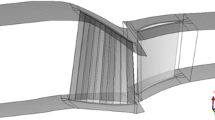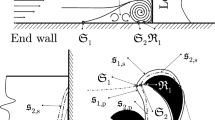Abstract
Experiments have been conducted to investigate surface roughness effects on the evolutions of loss and deviation downstream of a compressor blade row. Two cases - smooth (k+ = 1.27) and rough (k+ = 38.92) - have been investigated. Roughness has been attached to the blade suction side using a spray type glue gun and emery grain. At x/c = 0.2, 0.3 and 0.5 (downstream of the cascade), a five-hole probe has been used to measure the total pressure, mean velocity, and deviation at the mid-span. Static pressure taps on the blades have been used to measure the blade loading. When roughness is increased, the loss is larger and the loss increases more rapidly in the axial direction, indicating enhanced mixing. The deviation also increases at every measurement plane when roughness is increased. In addition, pitch-wise deviation distribution becomes uniform at x/c = 0.5 due to enhanced mixing.
Similar content being viewed by others
References
J. D. Denton, The 1993 IGTI scholar lecture: Loss mechanisms in turbomachines, Journal of Turbomachinery, 115 (4) (1993) 621–656.
J. P. Bons, A review of surface roughness effects in gas turbines, Journal of Turbomachinery, 132 (2) (2010) 021004.
J. P. Bons, R. P. Taylor, S. T. McClain and R. B. Rivir, The many faces of turbine surface roughness, Journal of Turbomachinery, 123 (4) (2001) 739–748.
R. P. Taylor, Surface roughness measurements on gas turbine blades, Journal of Turbomachinery, 112 (2) (1990) 175–180.
R. Leipold, M. Boese and L. Fottner, The influence of technical surface roughness caused by precision forging on the flow around a highly loaded compressor cascade, Journal of Turbomachinery, 122 (3) (2000) 416–424.
S. C. Back, J. H. Sohn and S. J. Song, Impact of surface roughness on compressor cascade performance, Journal of Fluids Engineering, 132 (6) (2010) 064502.
S. C. Back, G. V. Hobson, S. J. Song and K. T. Millsaps, Effects of Reynolds number and surface roughness magnitude and location on compressor cascade performance, Journal of Turbomachinery, 134 (5) (2012) 051013.
M. Lorenz, A. Schulz and H. J. Bauer, Experimental study of surface roughness effects on a turbine airfoil in a linear cascade—Part 2: Aerodynamic losses, Journal of Turbomachinery, 134 (4) (2012) 041007.
Q. Zhang and P. M. Ligrani, Wake turbulence structure downstream of a cambered airfoil in transonic flow: Effects of surface roughness and freestream turbulence intensity, International Journal of Rotating Machinery (2006).
F. E. Ames and M. W. Plesniak, The influence of largescale, high-intensity turbulence on vane aerodynamic losses, wake growth, and the exit turbulence parameters, Journal of Turbomachinery, 119 (2) (1997) 182–192.
Q. Zhang and P. M. Ligrani, Aerodynamic losses of a cambered turbine vane: Influences of surface roughness and freestream turbulence intensity, Journal of Turbomachinery, 128 (3) (2006) 536–546.
H. A. Schreiber, W. Steinert and B. Küsters, Effects of Reynolds number and freestream turbulence on boundary layer transition in a compressor cascade, Journal of Turbomachinery, 124 (1) (2002) 1–9.
M. Lorenz, A. Schulz and H. J. Bauer, Experimental study of surface roughness effects on a turbine airfoil in a linear cascade—Part 1: External heat transfer, Journal of Turbomachinery, 134 (4) (2012) 041006.
N. Abuaf, R. S. Bunker and C. P. Lee, Effects of surface roughness on heat transfer and aerodynamic performance of turbine airfoils, Journal of Turbomachinery, 120 (3) (1997) 522–529.
J. E. Dees and D. G. Bogard, Effects of regular and random roughness on the heat transfer and skin friction coefficient on the suction side of a gas turbine vane, Journal of Turbomachinery, 130 (4) (2008) 041012.
J. H. Sohn, Influence of blade surface roughness on flow characteristics in a linear compressor cascade, Department of Mechanical and Aerospace Engineering, Seoul National University, Seoul (2007).
E. M. Greitzer, C. S. Tan and M. B. Graf, Internal flow: Concepts and applications, Cambridge University Press, Cambridge, England, 3 (2007).
J. H. Shin and S. J. Song, Pressure gradient effects on smooth and rough surface turbulent boundary layers—Part 2: Adverse pressure gradient, Journal of Fluids Engineering, 137 (1) (2015) 011204.
J. W. Dreon Jr., Controlled diffusion compressor blade wake measurements, Naval Postgraduate School, Monterey, CA, USA (1986).
C. C. Koch and L. H. Smith, Loss sources and magnitudes in axial-flow compressors, Journal of Engineering for Power, 98 (3) (1976) 411–424.
H. Schlichting and K. Gersten, Boundary-Layer Theory, McGraw-hill, New York, USA, 7 (2003).
Author information
Authors and Affiliations
Corresponding author
Additional information
Recommended by Associate Editor Weon Gyu Shin
Dongjae Kong received B.S. in the School of Mechanical and Aerospace Engineering from Seoul National University. He is currently M.S. candidate at Turbomachinery Laboratory from Seoul National University. His current research interest is unsteady flow phenomena induced by impeller-diffuser interaction inside a centrifugal compressor.
Rights and permissions
About this article
Cite this article
Kong, D., Jeong, H. & Song, S.J. Effects of surface roughness on evolutions of loss and deviation in a linear compressor cascade. J Mech Sci Technol 31, 5329–5335 (2017). https://doi.org/10.1007/s12206-017-1027-y
Received:
Revised:
Accepted:
Published:
Issue Date:
DOI: https://doi.org/10.1007/s12206-017-1027-y




